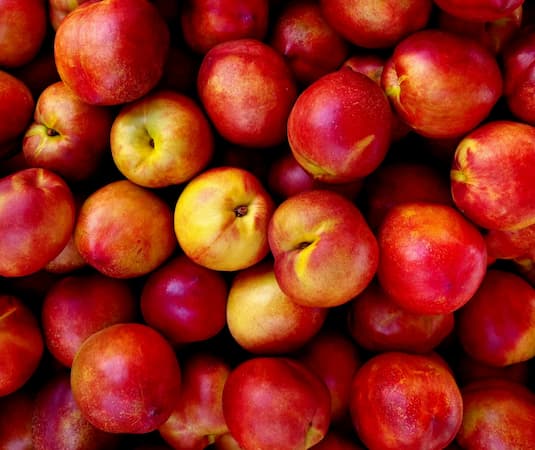How to Grow Nectarine Trees

About Growing Nectarine Trees in Your Yard
Nectarines are a lot like peaches. They have a taste similar to peaches. And, they are grown like peaches. Sweet and juicy, the most noticeable difference from peaches is their smooth skin. Peach skin is fuzzy. If you haven’t yet grown a nectarine tree, what are you waiting for!?? Use this guide on “How to Grow Nectarines” and you’re on your way to growing this tasty fruit.
Dozens of varieties of nectarines are separated into two types. The two types are Clingstone and Freestone. As the “Clingstone” name suggests, the fruit clings to the stone or pit. With “Freestone” varieties, the fruit readily separates from the pit with just a slight pull.
Nectarine Tree Specifications
Flower Colors: Varying shades of pink, depending upon variety and environmental conditions.
Flowers Bloom: Flowers bloom in late winter in southerly locations. They bloom in early spring in other areas of the country.
Fruit Ripens: Summer to Fall, depending upon what part of the country they are grown in.
Tree Height: 12 to 20 feet.
Light Requirement: Full sunlight.
Ideal Soil pH: 6.0 – 7.5.
Plant Hardiness Zones: 5 – 9.
Lifespan: They live an average of 15 – 20 years. Some trees can live for 30 years.
Number of Species: 50 to 60 varieties.
Botanical Name: Prunus persica var. nectarina
Light Requirements
Grow nectarine trees in full sun. Plant the trees in a location where they will receive 6 to 8 hours or more of bright, direct sunlight. The more direct sunlight the better. Sunshine directly affects fruit quantity and quality.
Nectarine Tree Propagation
Nectarine trees are grown from seed, the “pit”. A Nectarine tree takes three or four years to go from the seedling stage to a fruit-producing tree. Most people don’t want to wait that long. They turn to garden nurseries to purchase young trees that can be transplanted into your garden. The trees at your local nursery are a couple of years old. This small tree will still need to grow another year or two to get the first crop of Nectarines.
You can also graft branches from a Nectarine tree onto other fruit trees.
Planting a Nectarine Tree
Select a location in your yard that receives full sun. Dig a deep hole. Add plenty of decomposed compost, if available. Mix thoroughly with regular garden soil. If the tree you have bought is inside of a peat pot, leave it in the container. It is helpful (but not required) to slit the container to allow roots to more easily exit the container. While making the slits, be careful not to cut the roots, as you can do more harm than good. If your tree is in a burlap bag, remove the bag. Gently spread the roots in the hole you have dug.
Bury the plant up to where it was in the container. Soak the soil thoroughly. Add more soil if needed.
How to Grow Nectarine Trees
Once your new tree is planted, it should grow quickly. We recommend staking the tree in its first year of life. Strong winds can bend the young sapling, causing the trunk to grow at an angle. Really strong winds might even cause the tree to sway and damage roots.
Tip: Fruit tree fertilizer spikes are a great way to boost the growth of your new Nectarine tree. The spike slowly releases a fertilizer specifically formulated for fruit trees.
The size and number of Nectarines are dependent upon several things. As a rule of thumb, more Nectarines on a tree result in smaller individual fruit. Sometimes, mother nature pollinates a profusion of blooms. Sometimes frost nips a portion of the blooms. However, in a good year, so many Nectarines may be on the tree, that the size of the fruit is small. Growers can compensate for this, by removing a few of the baby Nectarines very early in the season. Should you do this? Probably not in your first few years of growth, as you do not have the experience to judge if there are too many Nectarines on the tree. But, we do recommend removing any Nectarines that are damaged by insects, leaving good Nectarines to grow even bigger.
Each spring, before buds open, apply a dormant oil fruit tree spray. This will kill a variety of insects.
Nectarine trees are susceptible to both insect infestations and disease. We highly recommend a regular program of spraying for both insects and plant diseases. If you use insect and/or disease sprays, we recommend you follow the directions on the label carefully. And by all means, wear protective clothing and a mask when spraying.
Birds and Animal Pests
Sometimes, birds will peck at the ripening fruit. Pest netting is an effective control measure while the tree is still small.
Some animals, notably opossum, like Nectarines. See Animal control suggestions
Harvesting Nectarine
Harvest fruit before it turns completely ripe. Once it is picked, it will soften and ripen quickly. The fruit will still be hard, making it easier to handle and store. Store fruit in a cool, dry place, out of sunlight.
Pruning Nectarine Trees
Like other plants, pruning established trees is healthy for them. It results in a bigger crop. Prune Nectarine trees annually in the early late winter or early spring, before the new year’s growth begins.
First, remove dead or unhealthy branches and limbs. Prune in areas where growth is very bushy. This will increase sunlight and air penetration, to help the overall health and growth of the tree. You can also prune branches to maintain a shapely-looking tree.
Related Articles
Also, people who read this article will like:
Please support our site. Shop for:
- rmmatthews100@hotmail.com
- 585-721-6528
- Rochester, NY
©1999-2024 GardenersNet.Com, All Rights Reserved

